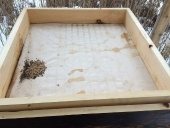




Angelika Maier wrote:I once or twice managed to grow oyster spawn from shop bought oysters on cardboard but they did not survive when I "planted' them outside, maybe I did not water enough.
I would like to try it once again but I don't like the plastic, even I can get the buckets for free - is it possible to grow oysters outside say in a wood chip pile? Or how about making a tower with chicken wire and filling it with wood chip? How much cardboard spawn would I need to how much woodchip 1:10 more less?
























My Food Forest - Mile elevation. Zone 6a. Southern Idaho <--I moved in year two...unfinished...probably has cattle on it.
















 1
1




Nick Dimitri wrote:Whoa there! "food grade" bucket may only mean the bucket has never been used to hold cleansers or other non-food safe toxic this or thats. Food grade may totally ignore what the bucket is actually made from but the oyster mycelium will eat what the bucket is made from, very probably petroleum based plastics. A relatively rubbery texture as compared to if grown in straw or whatever substrate out of reach of petro-products. Ugh, OgreNick
Regrets Last








Regrets Last

| I agree. Here's the link: http://stoves2.com |









